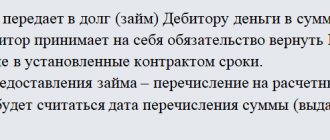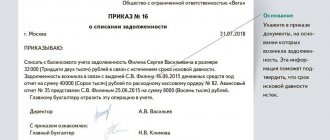Home / Rights
Back
Published: 04/16/2020
Reading time: 8 min
0
385
Russians who borrow money from their relatives and friends often behave irresponsibly. To protect yourself from the risk of non-repayment of funds, you need to issue a promissory note or loan agreement.
- Concept. Features for individuals and legal entities
- Differences between a loan agreement and a receipt
- The procedure for preparing a gratuitous loan agreement. Classification of agreements.
- Peculiarities
- Is notarization required?
- Contract structure
- Invalidation of the contract
When issuing a loan in favor of another person, it is necessary to comply with the written format of the transaction. If the transfer of money is made without accruing interest, then such a loan is classified as gratuitous. Since 2018, changes have been made to the Civil Code, which affected the procedure for issuing a loan from one person to another.
Concept. Features for individuals and legal entities
When a person lends money to a relative or friend, it is best to document this fact. In legal language, a document drawn up by relatives or friends among themselves is in this case called a gratuitous loan agreement.
The main document that regulates the procedure for issuing friendly or related loans is the Civil Code (CC). It has a special Chapter “Borrow and Credit” numbered 42.
The subject of the loan agreement is the transfer by the lender of money or securities into the ownership of the borrower. When transferring money according to the provisions of Art. 807 of the Civil Code, the borrower has a counter obligation: to return the same amount of money within the time period specified by law. The contract can stipulate that the loan is issued to one person, and another person will repay it.
Based on Art. 808 of the Civil Code, a written form of the contract is required when the contract amount is from 10 thousand rubles. In practice, citizens quite often resort to issuing a receipt, but it is not always enough. An agreement is a more preferable form than a receipt, especially when it comes to transferring large sums of money.
If a loan is given or received by a company, the agreement must be drawn up in written format, regardless of the amount.
Loans can be issued with or without interest. But it is possible that nothing was said in the agreement about interest and then the debtor usually returned the entire amount within a certain period without paying interest. Until 2021, this was the case: for contracts between individuals in the amount of up to 5 thousand rubles. and in the absence of any mention of interest, such a loan was automatically considered interest-free. But if the amount of the contract exceeded 5 thousand rubles, and not a word was said about interest, then interest could be claimed at the key rate of the Central Bank. From June 2021, all contracts worth up to 100 thousand rubles are considered interest-free, unless they contain any mention of interest. Thus, previously it was possible not to indicate the condition on the accrual of interest for loans from 5 thousand rubles. and still receive them, now this is allowed only for amounts over 100 thousand rubles.
Interest-free limit of 100 thousand rubles. now applies not only to people, but also to contracts with an entrepreneur. With regard to legal entities, the conditions remain the same: if the agreement does not contain any mention of interest, then it is considered that it was issued at a key rate.
How does this work in practice? Two individuals entered into a loan agreement for a year for 75 thousand rubles. and did not indicate percentages. In a year, the individual will return the amount of 75 thousand rubles, but it will not be possible to collect interest from him, since the amount does not exceed the limit.
If the contract is signed for the amount of 150 thousand rubles. without mentioning interest, then an individual, in addition to the amount of the principal debt (150 thousand rubles), can also be charged interest in the amount of the key rate (currently 6%).
Loan agreements have the goal of protecting the interests of the lender and, if necessary, will serve as evidence of the transfer of money in court. You can collect the principal portion of the debt, as well as interest in case of delay (based on Article 395 of the Civil Code). Interest will be accrued on that portion of the funds that the debtor has not returned within the due time frame. It will also be possible to recover from the debtor a fine and forfeit, legal and representation expenses.
How to calculate interest: formula and online method
To calculate interest under a loan agreement, the formula below is used. It is used both when the interest rate is set by the parties to the agreement, and in the case when the calculation should be made at the key rate of the Bank of Russia.
Interest amount = Loan amount × Interest rate / Number of days in a year × Number of days in the payment period.
IMPORTANT! If interest is calculated based on the key rate, then if it changes during the period of use of money, the payment period is limited to the duration of the rate. Then, from the moment the next key rate is introduced, a new calculation is made.
Example
An organization provided another organization with a loan in the amount of 100,000 rubles. for 30 days. The interest rate is 15% per annum.
In this case, the amount of interest will be equal to: 100,000 rubles. × 15% / 365 days × 30 days = RUB 1,233.
In total, to fully repay the debt, the borrower must pay the lender: 100,000 (principal debt) + 1,233 (interest) = 101,233 rubles.
In practice, loan agreements often have an appendix in the form of a schedule, which details each payment, including the amount of principal and the amount of interest payable in each payment period.
In addition, it is convenient to calculate interest on a loan online using a loan calculator. It is enough to enter the basic parameters into the proposed formula and get the required amount of interest.
Differences between a loan agreement and a receipt
A receipt is a more common form of securing debt obligations between parties. According to this document, one party transfers money to the other.
A receipt is a simplified form of a loan agreement, and a loan agreement is an expanded version of a receipt. The receipt contains an indication only of the loan amount and repayment terms, while the contract includes a wider range of information.
If a conflict situation arises between the parties and if the recipient fails to return the entire amount to the lender, the chances of collecting the debt under the loan agreement will be greater than under the receipt.
Despite all the differences, the loan agreement and the receipt do not exclude, but complement each other.
What to do if the receipt is not returned after repaying the debt
Article 812 of the Civil Code of the Russian Federation. Challenging the loan agreement
- The borrower has the right to challenge the loan agreement on the basis of its lack of funds, proving that money or other things were not actually received by him from the lender or were received in a smaller quantity than specified in the agreement.
- If the loan agreement must be concluded in writing (Article 808), challenging it due to lack of money through testimony is not allowed, except in cases where the agreement was concluded under the influence of deception, violence, threat, malicious agreement between the borrower’s representative and the lender, or a combination of difficult circumstances .
- If, in the process of challenging the loan agreement by the borrower due to his lack of money, it is established that money or other things were not actually received from the lender, the loan agreement is considered not concluded. When money or things are actually received by the borrower from the lender in a smaller quantity than specified in the contract, the contract is considered concluded for this amount of money or things.
The procedure for preparing a gratuitous loan agreement
A loan agreement between individuals (as opposed to legal entities) is considered concluded only at the moment of transfer of the loan and other subject of the contractual relationship, and not from the moment of signing. Confirmation that the agreement has been concluded is a receipt confirming the fact of transfer and receipt of money.
Under the loan agreement, it is allowed to transfer not only rubles, but also currency, subject to compliance with the provisions of Art. 140, 141 Civil Code.
The essential terms of the agreement are the subject - this is a certain amount of money, things and valuables transferred as the object of the loan. The content of the agreement is determined by the mutual obligations and rights of the parties to the signed agreement. But in fact, only the borrower has obligations under the agreement, that is, he must repay the loan amount within the established time frame (based on Article 810 of the Civil Code). The lender or creditor may require the borrower to return the loan item, as well as interest and penalties.
If the borrower is late in fulfilling his obligations, then a penalty may be demanded from him (under Article 330 of the Civil Code). The lender is relieved of the obligation to prove the fact of causing losses. The penalty can be accrued on the terms of the contract or according to the rules of the Civil Code (Article 332 of the Civil Code).
Classification of contracts
Loan agreements can be classified on various grounds:
- According to the status of the parties. Loan agreement between individuals, between an individual and a legal entity (IP), between legal entities.
- According to the form of the contract: oral and written form.
- According to the availability of interest: free and with interest.
Peculiarities
When signing a gratuitous loan agreement, it is worth keeping in mind the following features:
- If the borrower refuses to voluntarily repay the loan, the lender has the right to collect it in court. Additionally, this right does not need to be specified; it is guaranteed to the lender according to the law.
- The borrower has the right to return the received amount of money ahead of schedule without the consent of the lender, but the agreement may establish a different procedure.
- Changing the terms of the contract is possible, but only with the consent of both parties. To consolidate the changes, the parties sign an additional agreement.
- In contracts for the provision of a gratuitous loan agreement up to 100 thousand rubles. You can not indicate anything about the calculation of interest and this will make the loan free of charge. In contracts worth more than 100 thousand rubles. it must be stated that no interest is accrued on the loan amount, otherwise the lender has the right to charge an interest rate on the amount of the debt in the amount of the key rate.
Is notarization required?
There is no legislative requirement for mandatory certification of the loan agreement and promissory note. The parties will have to decide for themselves whether they will contact a notary. Notarization will confirm that the parties are legally capable, sign the agreement of their own free will and are aware of the consequences of their actions.
If the gratuitous loan agreement is certified by a notary, then it is drawn up in triplicate. One of them remains in the custody of the notary, and if the document is stolen, you can always request a duplicate from the notary.
It is also possible to transfer funds with the participation of a notary. If necessary, he will be able to confirm this fact in court.
Contract structure
The gratuitous loan agreement assumes the following structure and content:
- The name of the document, its number, place and date of conclusion of the agreement.
- Indication of the creditor and lender: full name, passport details, residential address.
- Indication of the borrower: full name, passport details, residential address.
- The loan amount in numerical and written format.
- The obligation of a borrower to repay the same amount of money within a specified time frame.
- An indication that the loan agreement is interest-free.
- Loan repayment terms (it is advisable to indicate a specific date).
- Information on the procedure for calculating penalties (if desired) or increased interest for late payments. The lender himself decides which method of calculating sanctions to choose. For example, penalties for each day of delay in the amount of 1/150 of the refinancing rate or no more than 100% of the loan amount.
- An indication of the method of securing the loan or collateral is allowed. This can be any valuable item from the borrower’s property, including real estate.
- Signatures of the parties.
The fact of transfer of funds under the agreement is confirmed by a receipt. A sample gratuitous loan agreement can be viewed here.
The loan agreement is drawn up in two copies, one for each party.
Invalidation of the contract
Based on Art. 812 of the Civil Code, the borrower has the right to challenge the loan agreement or promissory note and demand that the court declare them invalid. The following facts may be the basis for this:
- The fact of transfer of money from the lender to the borrower was not recorded anywhere - neither in the loan agreement, nor in the promissory note, or an act of acceptance and transfer of money was not drawn up.
- The agreement is not in writing, although the loan amount exceeds 10 thousand rubles.
- The signed gratuitous loan agreement contains gross errors in the details, for example, when indicating passport data.
- One of the parties was incapacitated at the time of transfer of funds.
- The loan agreement was signed under the influence of threats, deception, violence or fraudulent schemes.
- The money under the agreement was not transferred in full.
It is unacceptable to challenge a loan agreement in writing in court on the basis of witness testimony (unless we are talking about collection through threats, violence, etc.).
What is the procedure for paying interest under a loan agreement?
The payment period is not specified in the contract
If the agreement does not specify the payment procedure, interest for using the loan is paid monthly (clause 3 of Article 809 of the Civil Code of the Russian Federation).
The payment period is established by the contract
The parties may determine the following procedure for paying interest :
- one-time (one-time) payment of interest. The interest amount is calculated for the entire period of the contract;
- payment of interest at a certain frequency (weekly, quarterly). The interest amount is calculated for each period;
- payment of interest according to schedule. The schedule may provide for different payment frequencies. The interest amount is calculated for each period according to the schedule.
Interest payment deadline
The term for payment of interest is determined in one of the following ways (Article 190 of the Civil Code of the Russian Federation):
- calendar date;
- the expiration of the period (in years, months, weeks, days or hours);
- an indication of an event that is inevitably about to occur.
If a quarterly deadline for interest payment is established, you need to take into account that the quarters are counted from the beginning of the year (clause 2 of Article 192 of the Civil Code of the Russian Federation). Therefore, the interest payment period is calculated not from the moment the loan is received, but from the beginning of the quarter following the date of the loan, that is, from January 1, April 1, July 1 or September 1.
Collection in court
If the borrower does not repay the money under the loan agreement, the lender may go to court with a claim to recover money from the borrower under the loan agreement. When going to court, you need to remember that the law establishes a statute of limitations. Based on Art. 196 of the Civil Code, the general limitation period is 3 years . The agreement of the parties to revise the statute of limitations is invalid (under Article 198 of the Civil Code). But the statute of limitations is not automatically applied by the court.
In this case, the court will accept the statement of claim regardless of whether the statute of limitations has expired or not. One of the parties must apply for the expiration of the statute of limitations, and then the court rejects the claim (under Article 199 of the Civil Code).
The limitation period begins to count from the first day of delay in repaying the loan. Based on Art. 203 of the Civil Code, the limitation period is interrupted after the borrower acknowledges the debt. Such actions could be, for example, partial repayment of debt, the parties concluding an additional agreement to the loan agreement, etc.
If the statute of limitations is missed, the law allows them to be reinstated. The decision to restore the terms is made by the court, taking into account the valid reasons. This is, for example, serious illness, helplessness, illiteracy, etc. Such reasons can be taken into account if they have occurred over the past six months (based on Article 205 of the Civil Code).
If the borrower voluntarily repays the loan amount in full after the statute of limitations has expired, he does not have the right to demand that the loan be returned (based on Article 206 of the Civil Code).
Article 811 of the Civil Code of the Russian Federation. Consequences of violation by the borrower of the loan agreement
- Unless otherwise provided by law or the loan agreement, in cases where the borrower does not repay the loan amount on time, interest is payable on this amount in the amount provided for in paragraph 1 of Article 395 of this Code, from the day when it should have been repaid until the day its return to the lender regardless of the payment of interest provided for in paragraph 1 of Article 809 of this Code.
- If the loan agreement provides for the return of the loan in installments (in installments), then if the borrower violates the deadline established for the return of the next part of the loan, the lender has the right to demand early repayment of the entire remaining loan amount along with the interest due.







